Adam Booth | December 24, 2016
Six motorcycles, one winner. Will a new king be crowned?
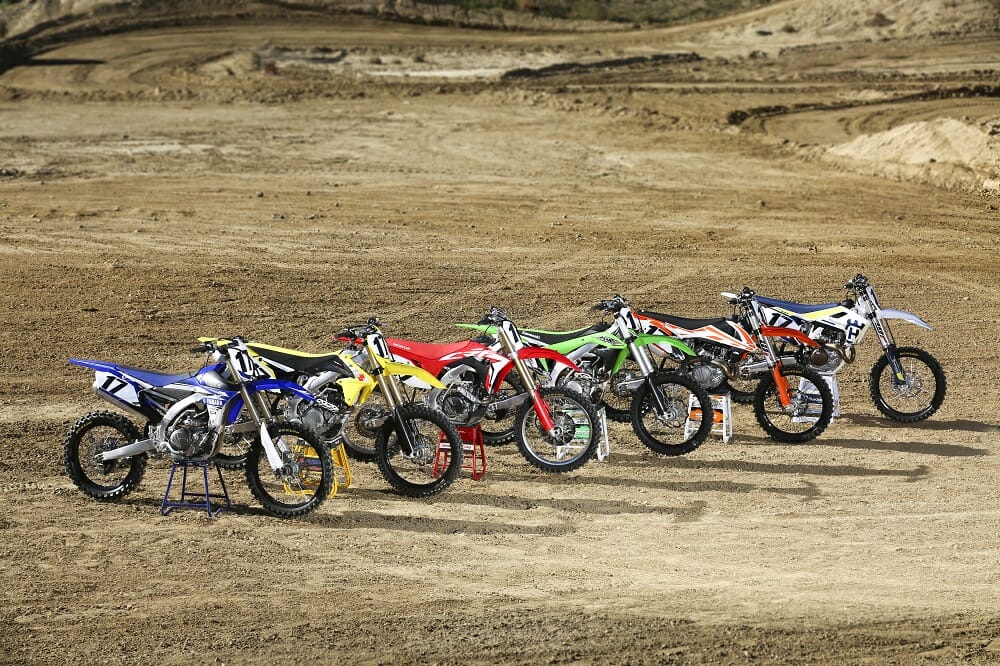
The 2017450 Cycle News Motocross Shootout features six motorcycles that are all impressive machines. Every year the performance gap gets smaller and smaller in the 450 class, making it hard to find fault in any of the models and making it difficult to choose a clear-cut winner. The Yamaha YZ450F is the defending shootout winner and has been for the past two years. With big changes from Honda, KTM and Husqvarna it will be harder for the YZ to retain the title of 450-class leader, which took on few changes fore 2017. With lots of hours of testing at different tracks, there has to be a winner, and we did, indeed, find one.
During our testing we kept the bikes as close to stock as possible. The only adjustments we made to either the engines or suspensions were the ones that came available with each bike, though we did make them look a little prettier thanks to the graphic folks at Factory Effex.
We tested at multiple tracks in Southern California with a wide range of riders ranging in both age and ability. We take every aspect of the bike into consideration when choosing the rankings. We spent a lot of time going back and forth on each bike, really picking away at the differences. This shootout wasn’t easy as the top finishers were very close. In case you’re wondering, we opted not include 350F or 250 two-strokes in this shootout, just the big dogs.
The Contestants
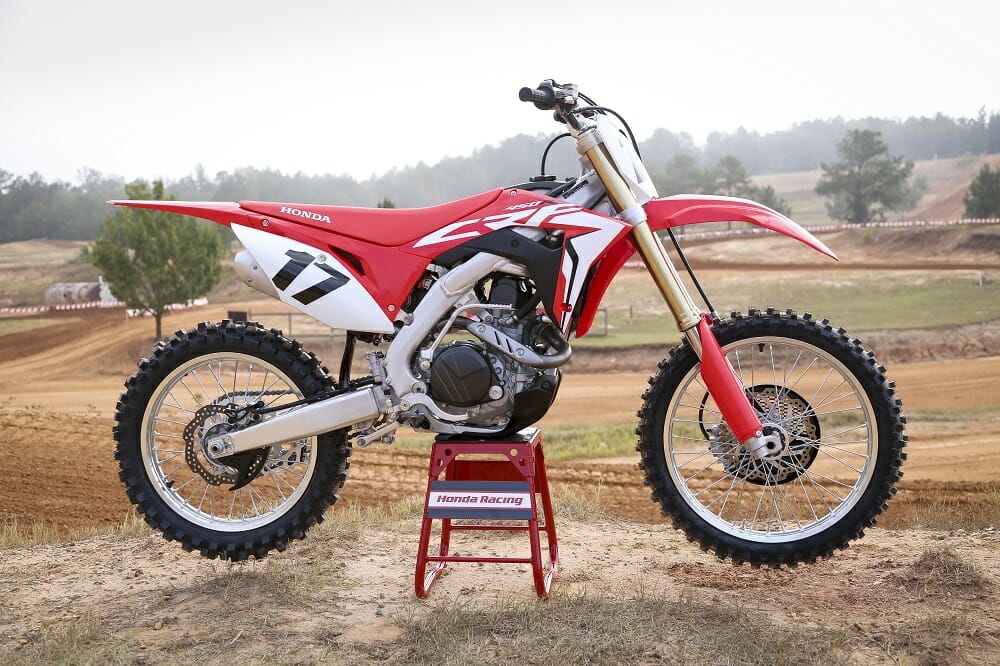 Honda CRF450R
Honda CRF450R
This (2017) is an exciting year for Honda 450 lovers; the CRF450R is all new from the ground up. It is faster, better handling and, the big news, it now has a spring fork. No more air fork for the Honda. So, is a total revamping enough to return the Honda to the head of the class?
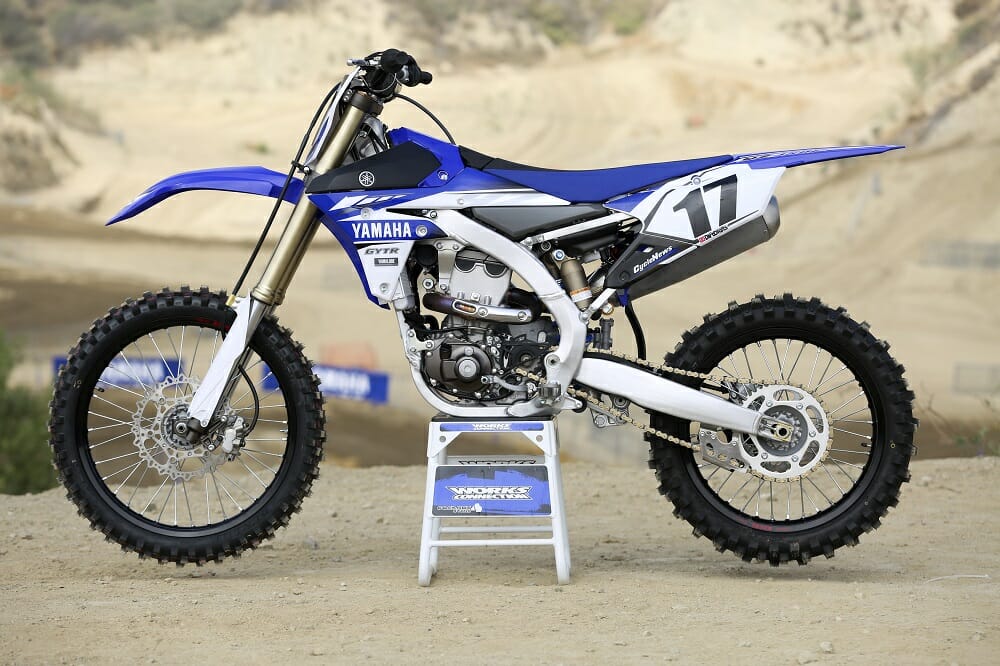
Yamaha YZ450F
Not wanting to mess with a good thing, Yamaha left the 2017 YZ450F alone, which might not be a bad thing, as it has won the Cycle News 450 MX Shootout for the past two years. But, in 2016 it didn’t win by much. Of note, Yamaha has stuck with the Kayaba SSS spring fork through the air fork rage and it has proven a wise choice.
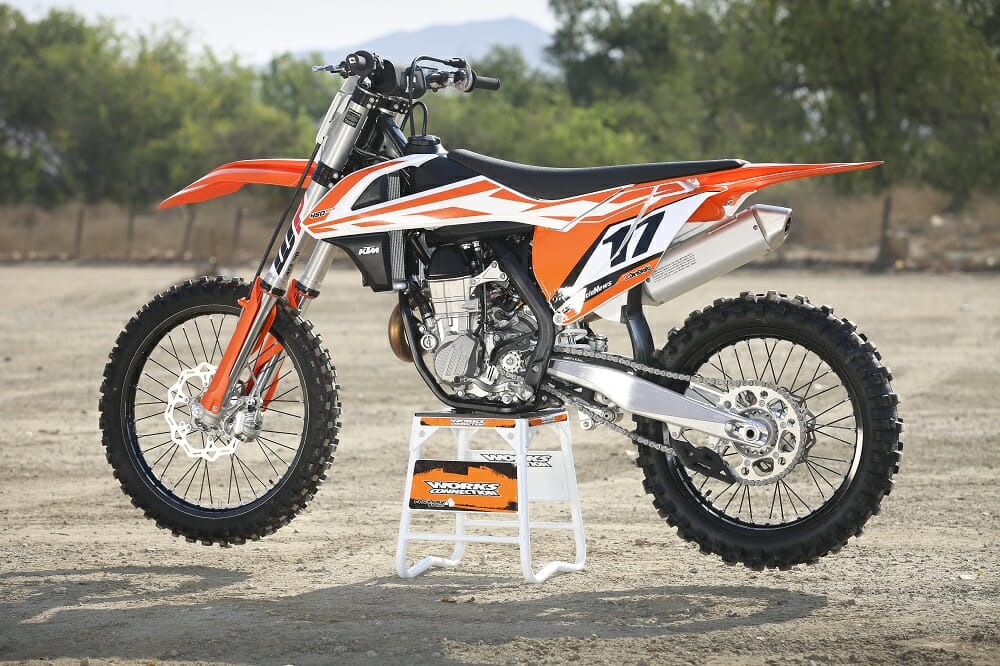
KTM 450 SX-F
Finishing second in last year’s shootout, the KTM 450 SX-F sees some significant changes for 2017, one of those being the swap to WP AER48 air forks. They work much better than the previous WP 4CS fork and are 3.5 pounds lighter. Is this enough to bump the KTM past the reigning champ?
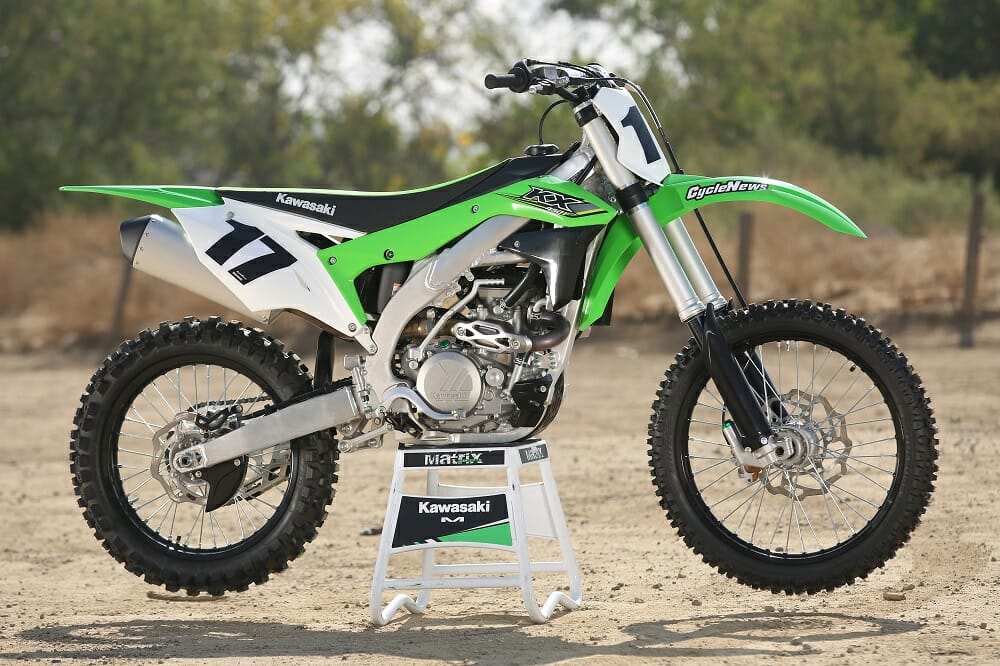
Kawasaki KX450F
In 2016, the KX450F received a complete overhaul. It lost weigh and the engine saw improvements in power. For 2017, the KX450F remains virtually the same minus a few small revisions. Like the RM-Z450, the KX450F uses Showa’s TAC air forks but with different internal settings.
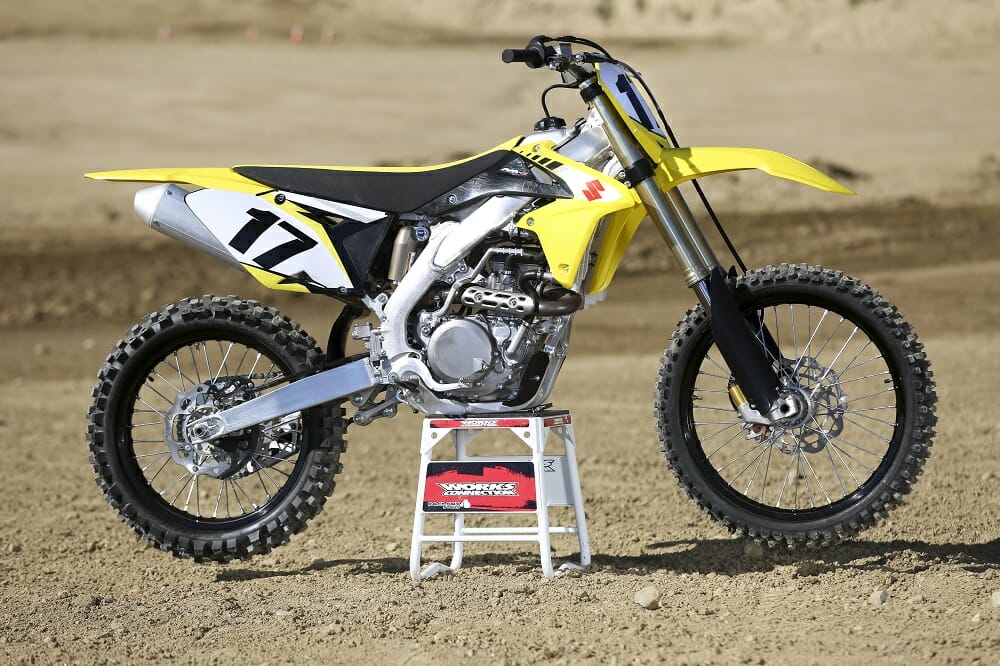
Suzuki RM-Z 450
The long-in-the-tooth Suzuki RM-Z450 has proven it can win; most recently Ken Roczen, Ricky Carmichael and Chad Reed are fine examples of that over the years. The RM-Z450 has also remained relatively unchanged for nearly a decade and 2017 isn’t any different. It unfortunately holds the title as one of the heaviest of the six 450 motocrossers, but is still one of the best cornering bikes out there.
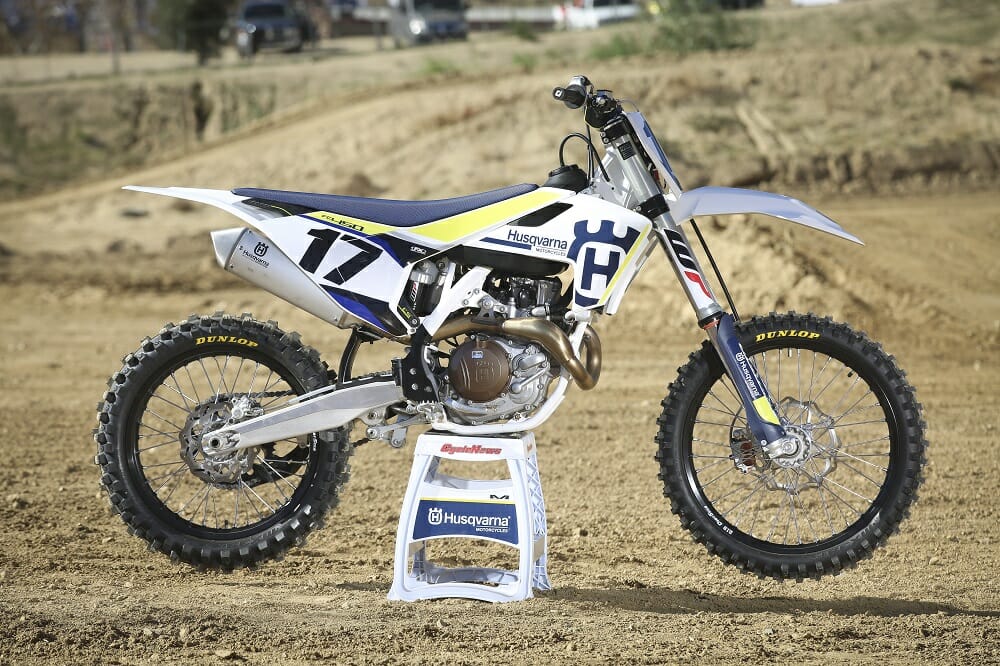
Husqvarna FC450
Like the KTM, the Husqvarna FC 450, which rolled off the same assembly line as the SX-F, received the 3.5-pound lighter AER48 air fork, making it the second lightest bike in the shootout. It now shares more with its KTM clone than it used to. It now shares Dunlop MX3S tires (last year the Husky used MX52 tires) and the same suspension settings. Will these changes help it jump up in the ranks?
6th place – Suzuki RM-Z450
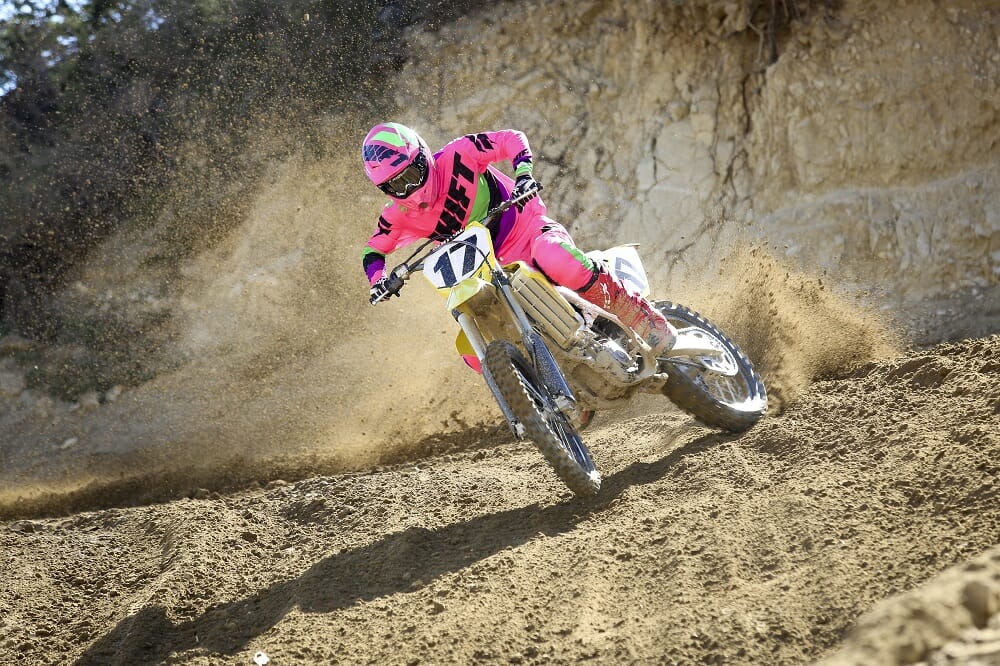 The huge advantage the RM-Z450 once had in the turns is getting smaller. It’s still the best but the KTM/Husqvarna and Honda have narrowed that gap significantly.
The huge advantage the RM-Z450 once had in the turns is getting smaller. It’s still the best but the KTM/Husqvarna and Honda have narrowed that gap significantly.
For 2017 the Suzuki RM-Z450 received just minor cosmetic changes, otherwise, this is the same machine as 2016.
All riders, from beginner to pro, agreed the Suzuki engine is great. It isn’t the outright most powerful, but it is super easy to ride and makes very strong and usable power. We preferred using the white coupler (lean fuel mixture and more aggressive power delivery) because it added a little more excitement out of corners and stronger pull on loamy track conditions.
In a class that is ever changing, the famous-for-turning RM-Z450 is stuck in the past when it comes to suspension. Air forks were supposed to be the new cool thing for the dirt bike world but they didn’t live up to the hype. The Showa TAC air fork is simply the RM-Z450’s downfall and holds it back from finishing higher in the shootout. The Kawasaki KX450 uses the same Showa TAC fork as the Suzuki but with different—and better—settings.
Overall the Suzuki has harsh feel, and it isn’t just from the suspension. The general opinion amongst our testers was that the Suzuki just felt stiff, which is nothing new really. This is fine on a smooth track with lots of turns and jumps (think supercross) but when the bumps begin to develop, the suspension shows its weaknesses. Hitting harsh bumps and even braking bumps can feel like riding into a curb on the Suzuki. We have tried just about every setting on the TAC fork with little positive results. Either it is way too harsh or it is just plain harsh with a tendency to blow through the stroke. The RM-Z450 is an amazing turning bike, especially if there aren’t any big bumps or harsh hack leading into the corner. It is the best bike to rip the inside line in a corner. While it has ruled the class for a long time in the turns, others, like the KTM/Husky and Honda, are giving it a run for its money now.
We can’t stress enough that the Suzuki RM-Z450 isn’t a bad dirt bike; in fact it has a lot of potential, especially if you spend some time getting the forks dialed in. We’re convinced that a better spring fork (or even a better air fork) would do wonders for this motorcycle.
A serious diet would help, too.
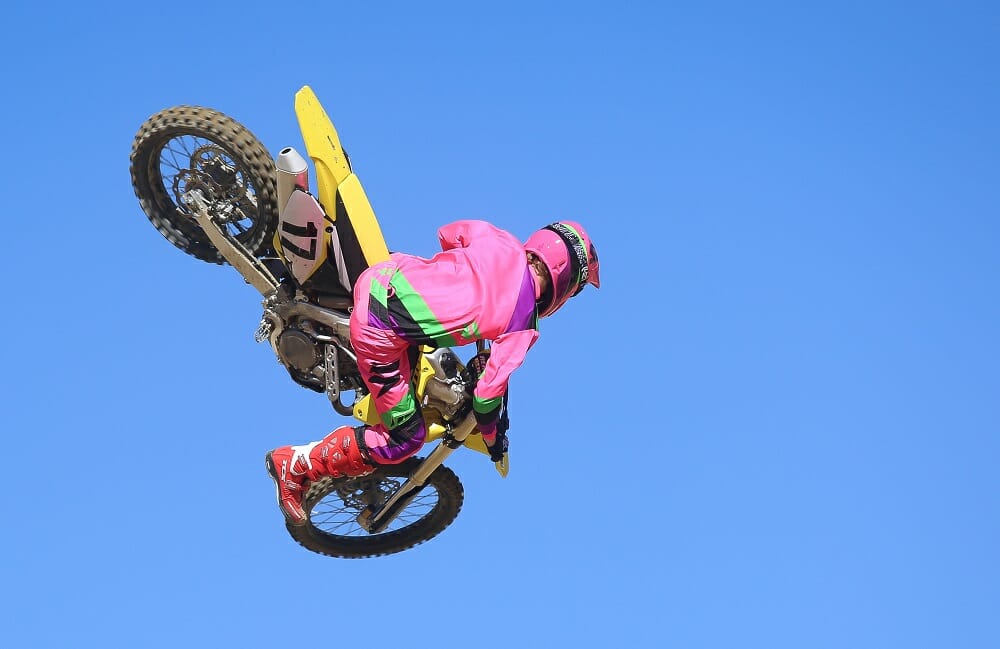 Ridged chassis, razor-sharp turning and a torquey engine make the RM-Z450 a great choice for Supercross.
Ridged chassis, razor-sharp turning and a torquey engine make the RM-Z450 a great choice for Supercross.
|
PROS
|
CONS
|
IMPORTANT NUMBERS
|
|
Easy to turn
|
Complex forks
|
Weight (full fuel): 248.0 lbs.
|
|
Broad power delivery
|
Rigid chassis
|
(w/o fuel): 236.0 lbs.
|
|
Comfortable ergos
|
Dated looks
|
MSRP: $8,749
|
|
Easy to start
|
Heavy
|
|
5th Place – Kawasaki KX450F
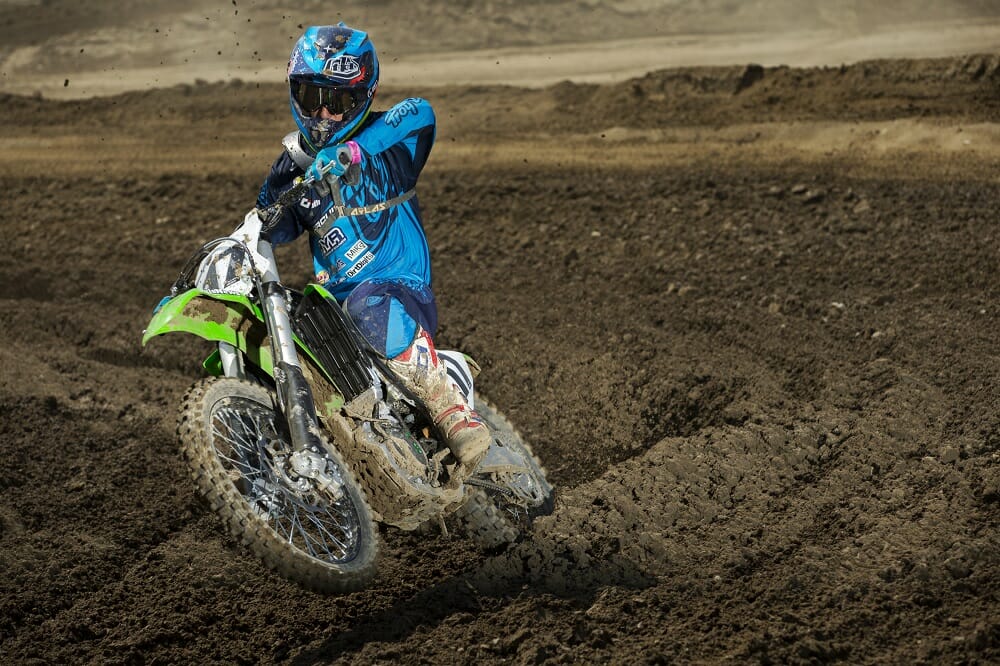 The KX450F is an excellent bike. It’s a lot better than its fifth-place rating might suggest. Not much separates first from sixth in this shootout.
The KX450F is an excellent bike. It’s a lot better than its fifth-place rating might suggest. Not much separates first from sixth in this shootout.
The 2016 Kawasaki KX450F was a completely redesigned model in hopes of regaining the top spot in the class, a spot it once held for many years. While the redesign was successful, it didn’t earn the KX450F the shootout win in 2016; that, instead, went to the YZ450F. The KX450F lost even more ground in our 2017 shootout and blame goes to the all-new Honda CRF450R and an improved Husqvarna FC 450. Both jumped up in the final rankings, pushing the KX450F back to its fifth place position.
The KX450F powerplant is strong and smooth. It is very responsive and snappy with good bottom and a very strong and broad midrange. Depending on the track and conditions, many riders preferred to use the black coupler, mellowing out the ultra snappy off-idle response. It doesn’t hurt overall output; it just rolls on a bit smoother, offering better control through the corners. Once out of the midrange the top-end pull isn’t as strong as the KTM/Husky or the Yamaha, but offers plenty for most riders. Most riders don’t want to rev a 450 to find the best power. It isn’t the most thrilling power character, but it is very good and providing forward momentum and excellent rear wheel hook up.
Nothing has changed with the KX450F exhaust note, it is still crazy loud, yet they aren’t alone, Yamaha and Honda now join the ranks of crazy loud exhaust. For engine tuning beyond swapping out the adjustable couplers (which come with the bike), Kawasaki offers a handheld engine tuner (sold separately), so you can easily fine-tune the engine’s ECU. It also has; of course, launch control (as do the KTM, Husky, Yamaha and Suzuki).
The Showa SFF TAC air fork works better with the 2017 internal changes and was an improvement in 2016 thanks to the chassis changes. Triple air chamber air fork still requires a lot of attention when it comes to set up. The internal settings are different than the SFF TAC fork on the RM-Z450 and work much better than the Suzuki’s. Still, the KX’s forks trails the others in performance out of the box. For 2017, the suspension and triple clamps revisions have helped further front-wheel traction and balance of the KX450F, improving cornering a little over the 2016 model. Overall the KX450F is balanced and stable, working well on a variety of tracks. The KX450F still doesn’t carve a corner like the Suzuki, KTM/Husky or Honda, but it is consistent and predictable.
The Kawasaki is the most adjustable motorcycle of the group. It is the only bike with adjustable footpegs and also has multi-way adjustable handlebars.
Landing in fifth place sounds way worse than it is for the KX450F. In reality it isn’t far from the now fourth-place finisher, the YZ450F, which isn’t that far off the third place finisher, the Honda CRF450R (which isn’t that far off the second-place finisher, which…). The reality is that all the bikes work very well and each bike varies in ways that suit riders in different ways.
Without question, the Kawasaki is a great bike. The bummer for Kawasaki boils down to suspension performance, which is easily better than the Suzuki RM-Z450, but was beat out by everyone else.
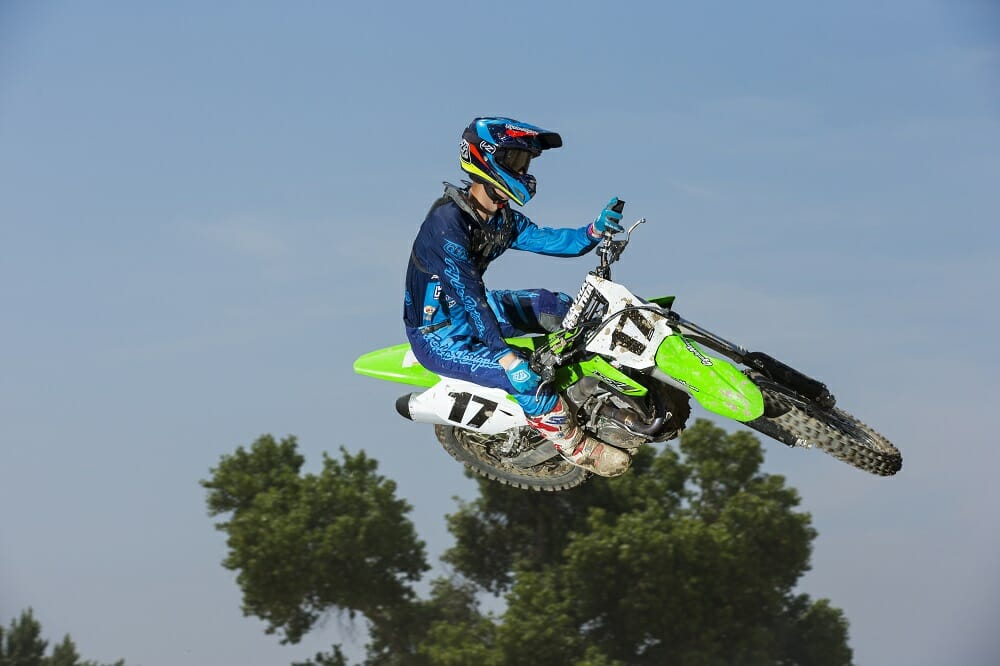 Mediocre forks held the KX back a bit. Otherwise, the KX would be in the running for top dog.
Mediocre forks held the KX back a bit. Otherwise, the KX would be in the running for top dog.
|
PROS
|
CONS
|
IMPORTANT NUMBERS
|
|
Strong yet manageable power delivery
|
Complex forks
|
Weight (full fuel): 241 lbs.
|
|
Solid chassis that’s easy to control
|
Loud exhaust
|
(w/o fuel): 231.0 lbs.
|
|
Wide range of adjustability
|
|
MSRP: 8,849
|
4th Place – Yamaha YZ450F
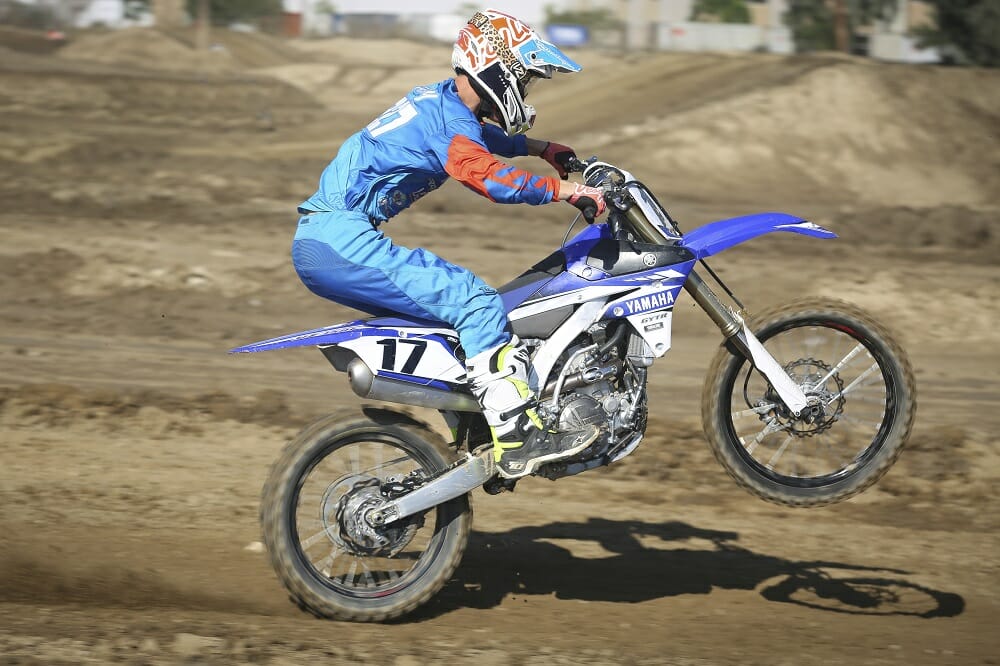 The Yamaha might’ve lost its shootout crown but we still love the YZ450F for its great engine and outstanding suspension.
The Yamaha might’ve lost its shootout crown but we still love the YZ450F for its great engine and outstanding suspension.
The Yamaha YZ450F has held the honor of being the Cycle News 450 shootout champ for the past two years. Last year, the KTM came close to beating the Yamaha but couldn’t beat the YZ’s beloved Kayaba SSS fork and overall suspension package. Through all the air fork hype, Yamaha stuck with traditional spring forks, relying on the “why fix what’s not broken” philosophy, which helped Yamaha earn a lot of shootout wins. For 2017, Yamaha didn’t change much on the YZ450F. It got updated rear-brake-rotor material that improves heat resistance, increases durability and improves feel. The biggest change from 2016, however, was the switch to Dunlop MX3S tires.
The YZ450F engine for years has been known as simply the best engine in the class. It has great off idle response and torque that pulls into a massive midrange with the ability to keep churning out strong power into the upper rpms. It might not make the most horsepower in the 450 class, that honor goes to the KTM and Husqvarna, but they make those max horsepower numbers at very high rpms. The Yamaha provides huge power through the mid, where most riders need it most. The YZ450F is the most responsive engine of the group, so much that a lot of riders prefer to use the GYTR power tuner accessory to mellow the hit right of idle to help maintain forward drive. Clutch action and pull is very smooth without fading.
Thankfully Yamaha didn’t jump on the air fork bandwagon a few years ago and it paid off. Again, why fix something that isn’t broken? And the YZ’s KYB suspension is far from broken. It is still the best overall suspension in the 450 class. It is plush while resisting bottoming. The nastier the track and the bigger the bumps, the more the Yamaha shines. The SSS fork is also easy to maintain and adjust, a bonus to being the top-performing fork.
Now that the Husqvarna, KTM and Honda turn amazing and have improved suspension, the tendency for the Yamaha to stand up in corners is more evident. The YZ’s vague cornering characteristics used to be much easier to overlook thanks to amazing suspension and excellent engine character. The Yamaha hasn’t lost any of the attributes that helped it win the Cycle News shootout for the last two years; the other manufactures have stepped up their game and provided machines that are now out performing the Yamaha most of the time. Again, on the most hacked up and terrifyingly rough tracks, the Yamaha is amazing. Combining the YZ’s class-leading suspension with its outstanding chassis and solid motor makes an excellent overall package that used to be unbeatable. It is the widest feeling bike between your legs and ranks right up there with the loudest exhaust.
Our test riders who last year voted the YZ450F as number-one still love the bike, they just like the improved KTM, Husky and Honda a little more. The YZ450F needs to go on a diet, however. With full tanks of gas the YZ450F weighs 15 pounds more than the KTM 450 SX-F and 12 pounds more than the Husqvarna FC450, and the YZ, KTM and Husky all have two-gallon tanks.
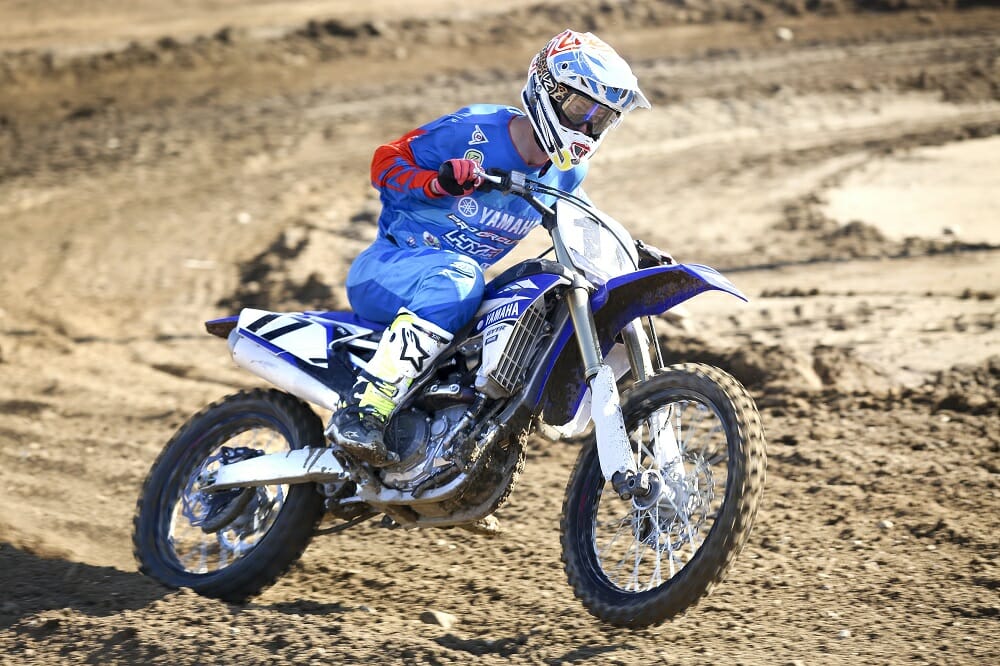 In order for the YZ450F to get back on the top step of the podium, it will have to lose some weight.
In order for the YZ450F to get back on the top step of the podium, it will have to lose some weight.
|
PROS
|
CONS
|
IMPORTANT NUMBERS
|
|
Best suspension, excellent forks
|
Widest shrouds of all bikes
|
Weight (full fuel): 248 lbs.
|
|
Strong/lively power delivery
|
Overly loud
|
(w/o fuel): 236.0 lbs.
|
|
Great reputation for durability
|
Vague cornering
|
MSRP: $8699
|
|
Lowest MSRP
|
Heavy
|
|
3rd Place – Honda CRF450R
 If you liked the way the ’09 CRF450R handled (before its major chassis change in 2010), then you’re going to love the new 2017 CRF450F. It feels just like the ‘09, only better.
If you liked the way the ’09 CRF450R handled (before its major chassis change in 2010), then you’re going to love the new 2017 CRF450F. It feels just like the ‘09, only better.
What a difference a year can make. The Honda CRF450R went from fourth in last year’s shootout to being seriously considered for the top spot in this shootout. The all-new bike really addressed past issues and the Honda crew has a bike that is not only faster, but is also better handling—a great combo.
The all-new 2017 Honda engine has improved torque throughout the rpm range and peak horsepower numbers are up, all while revving higher. The downdraft style intake tract helps boost overall power substantially. The more powerful 2017 CRF450R engine now ranks right up in the mix amongst the fastest 450s while putting power to the ground in a controlled and predictable way. Forward drive is excellent.
None of our testers complained the 2017 Honda wasn’t fast enough. We noticed the all-new CRF450R is also louder than in years past, on par now with the loud YZ and still loud KX.
The clutch revisions reduced the fading problem that typically plagues the CRF450R, and feel has improved.
The strong and snappy engine helps the CRF450R feel lighter and more responsive. A handlebar mounted map switch also makes it easier to go between the three maps. Our fasted riders liked the stock and aggressive maps, while a majority of riders liked the mellower map, which made rolling on the gas and modulating the power easier while still providing plenty of boost. The mellow map was a common choice later in the day as the tracks dried up.
Kick starting the Honda isn’t nearly as easy as the other bikes in the shootout that utilize a kick starter. It likes a smooth full kick but with effort to fire up. Honda does, however, offer an electric-starter kit for the CRF that is ready to be installed. It will, however, set you back another $650 and add about eight pounds.
Honda made a bold move and ditched the air fork for a traditional spring fork. The Showa 49mm spring forks are as close to A-Kit forks as you can get, minus the DLC coating. The consumer spoke and Honda listened. It—springs in the forks—added some weight but Honda shaved weight in other areas to offset the slight addition. The 2017 Honda CRF450F weighs exactly what the 2016 did, 245 pounds with a full tank of gas.
The 2017 Honda CRF450R is back to typical Honda standards, which means it is a comfortable and easy bike to ride. In less than a lap every rider felt at home on the CRF450R. It is a bike that doesn’t do anything weird or unexpected. Cornering is effortless and controlled. It doesn’t matter if it is a rutted corner or a flat and slippery corner; the CRF450R handles it with ease. The chassis plays a big role in how the Honda corners but the big thank you goes out to the new spring fork. It offers a ton of feedback and keeps the front wheel connected to the ground better. New frame geometry helps, as well. We understand that the new chassis is modeled after the ’09 chassis, which was generally well liked and greatly missed after a redesign in 2010.
Overall the Honda’s suspension is very balanced, working well for a wide range of riders. The overall suspension feel is plush and for some on the soft side, which is better for the general public and average rider. Top pros, and we’ve said this before, will change the suspension right away and are more worried about engine and overall chassis performance versus stock suspension settings.
The CRF450R isn’t a feather weight, it is 12 pounds heavier than the winning KTM 450 SX-F, but that weight isn’t as noticeable on the track where the Honda is very light and nimble and easy to throw around. Honda did a good job of keeping the weight low in the chassis. However, they could’ve lost more if they ditched its dual muffler system for a single muffler system.
All the changes to the Honda really improved the bike, enough that it beat out last years winner, the YZ450F on almost all tracks. The only time the Yamaha had an advantage was on a really hacked up and blown out track.
The 450 class is much closer to call than the 250F class and the bottom line is that each bike is very good. Really, the 2017 Honda CRF450R is a second-place bike, but since the KTM and Husky are virtually the same bike (but not as close as the 250Fs), the Honda gets pushed back to third behind the two lightest production motocross bikes.
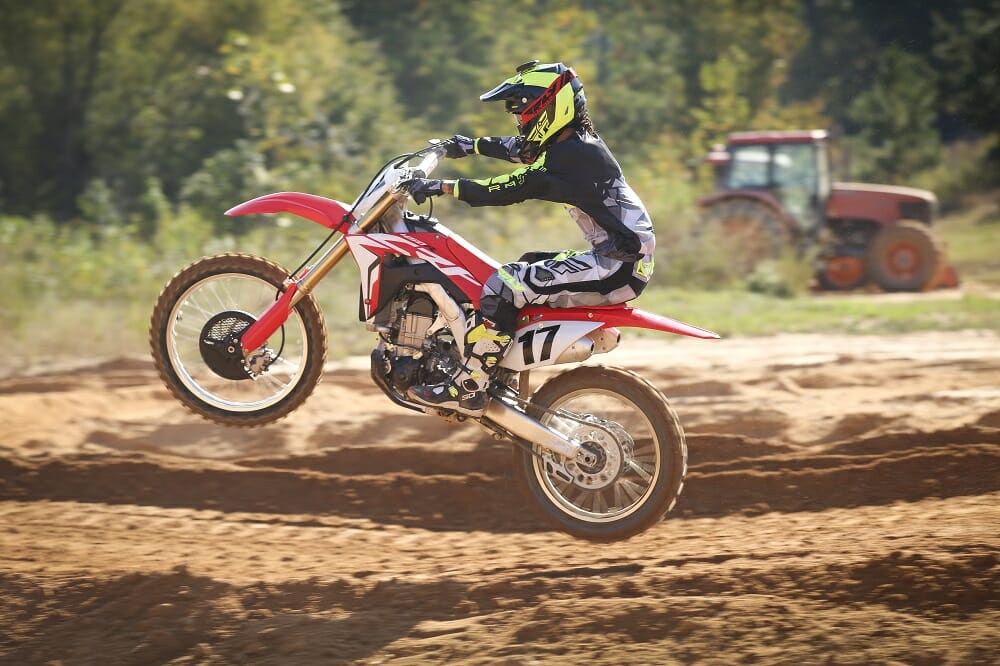 We found the new CRF to be very potent but still easy ride. Novices will like the Honda just as much as the pros will.
We found the new CRF to be very potent but still easy ride. Novices will like the Honda just as much as the pros will.
|
Pros
|
Cons
|
IMPORTANT NUMBERS
|
|
Excellent Engine
|
A little tough to start
|
Weight (full fuel): 245 lbs.
|
|
Great turning
|
One of the loudest 450s
|
(w/o fuel): 234.8 lbs.
|
|
Good suspension
|
Dual mufflers
|
MSRP: $8,849
|
2nd Place – Husqvarna FC 450
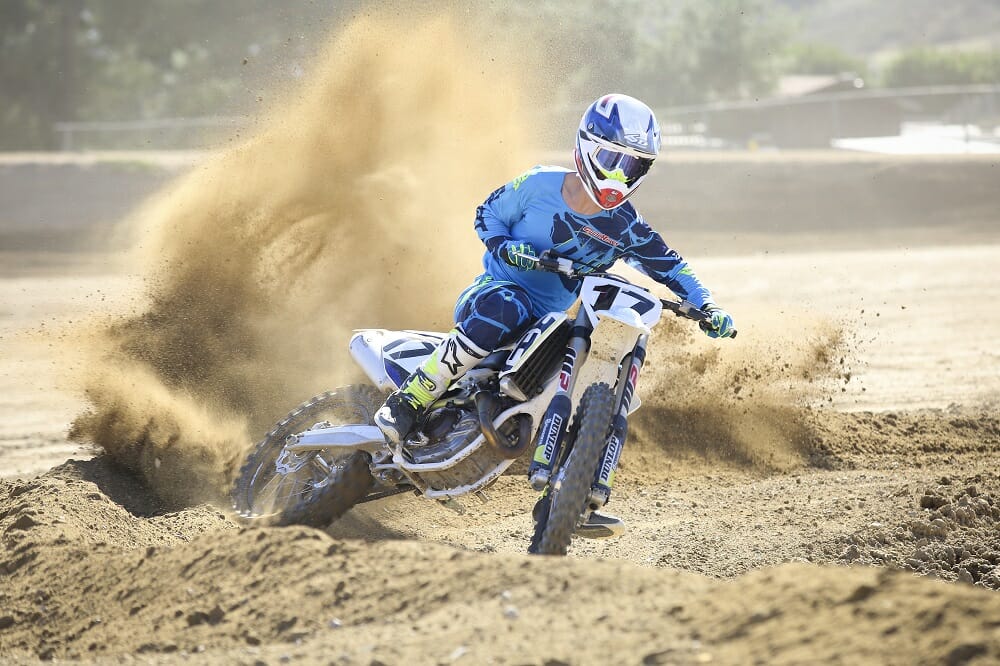 The spectacular Husky is pretty much a white KTM, but there are subtle differences.
The spectacular Husky is pretty much a white KTM, but there are subtle differences.
Even though they come out of the same factory, there are very slight differences between the Husqvarna FC 450 and the KTM 450 SX-F, more so than in our 250F shootout where the Husky and KTM tied for the same position because they are just too close of being the same bike. The addition of Dunlop MX3S tires on the 2017 FC 450 helps brings the feel of the bike on the track closer to its virtual clone, the KTM 450 SX-F. Compared t the KTM, the Husky has an FIM-compliant muffler that is slightly more restrictive, a composite (versus aluminum) subframe, a Magura hydraulic clutch (KTM’s is Brembo), different GSK brake rotors, and different D.I.D rims. Everything else is identical, even ECU mapping and suspension settings. The composite subframe and muffler are slightly heavier than the KTM’s. Add it all up and the Husky weighs 2.5 pounds more than the KTM at 235.5 pounds (full tank of gas).
The Husqvarna’s engine, ECU and exhaust header are identical to the KTM 450 SX-F. The Husky’s muffler looks similar to the KTM’s but has a screen cone inside to reduce noise. The air box is also a little more restrictive than the KTM’s. These differences mean the FC 450 engine feels very similar to the KTM, just a hair down on power through the bottom and midrange. When the Husqvarna engine gets into the upper midrange and top-end, the power feels on par with the KTM. Some testers, though, felt the Husqvarna pulls slightly harder right at the top of the rpms.
On the dyno the two engines put out nearly the same numbers, the Husqvarna just revs a little slower and isn’t quite as snappy as the KTM. On the track the Husky’s power delivery comes on slightly softer (because of the more restrictive muffler and airbox) but progressively gets stronger as it goes. The Husky has one of the most powerful engines in the class; it’s just not as exciting as the others.
Some testers said that the Husky lacked hit, but then went on to say they went just as fast on the Husky but with less fatigue. The ultra-smooth delivery is also welcomed when the track gets more slippery. Traction control? Yes, it works! Like you probably, we had our doubts when we first heard about TC on a dirt bike, and then we tried it. We’re believers now. A favorite setting amongst test riders was map “2” with traction control turned on. Overall the Husky has a great engine and its plenty fast.
The switch from the WP 4CS fork to the WP AER48 air fork is what helped propel the Husqvarna into the second position right behind the winning KTM. The FC 450 is a great handling machine; it turns quickly and with razor sharp precision, all while staying very stable at speed. Usually when a bike corners as well as the FC 450 it exhibits nervous when going fast, especially when entering corners. The Husky doesn’t show any signs of twitchiness. The chassis, combined with the suspension and smooth engine character creates a bike that is easy to ride in all situations. The fact that it is the second lightest bike in the shootout, even with electric start helps with the light and nimble feel.
It would have been easy to claim the Husky and the KTM tied for the second spot but there are couple differences that translate into a slightly different feel out on the track. If you want the Husky’s engine to perform like the KTM 450 SX-F, install the less restricted KTM muffler and open up the Husky air box a little. Also, the bodywork is a little different and the Husky seat is a bit higher than the KTM’s, putting the rider in a slightly different position when seated. Testers were mixed when it came to which bike they liked more, the Husky or the KTM, but in the end, more riders chose the KTM to slightly edge out the Husqvarna. The hard reality is that the Husqvarna and KTM are only separated by a muffler, airbox airflow and bodywork.
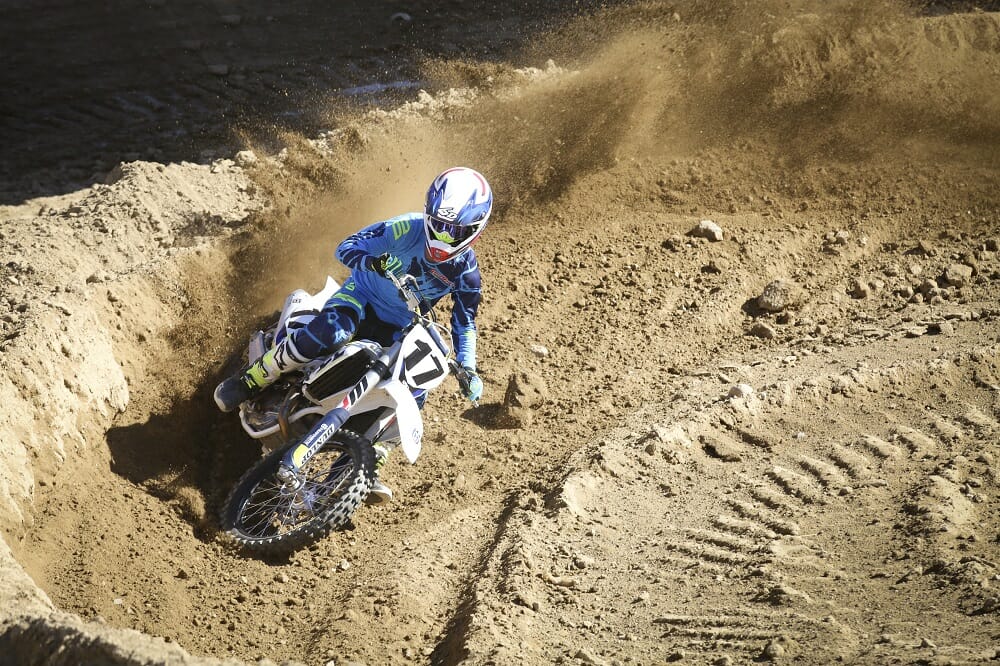 The only real thing standing between the Husky and the winning KTM is their exhaust systems. The Husky’s is more restrictive.
The only real thing standing between the Husky and the winning KTM is their exhaust systems. The Husky’s is more restrictive.
|
PROS
|
CONS
|
IMPORTANT NUMBERS
|
|
Second lightest 450
|
Soft power delivery
|
Weight (full fuel): 235.5 lbs.
|
|
Electric (super-easy) starting
|
Most expensive of class
|
(w/o fuel): 224.1 lbs.
|
|
WP AER48 air fork
|
|
MSRP: $9499
|
|
Very usable power delivery
|
|
|
|
Hydraulic clutch
|
|
|
|
Strong brakes
|
|
|
1st place – KTM 450 SX-F
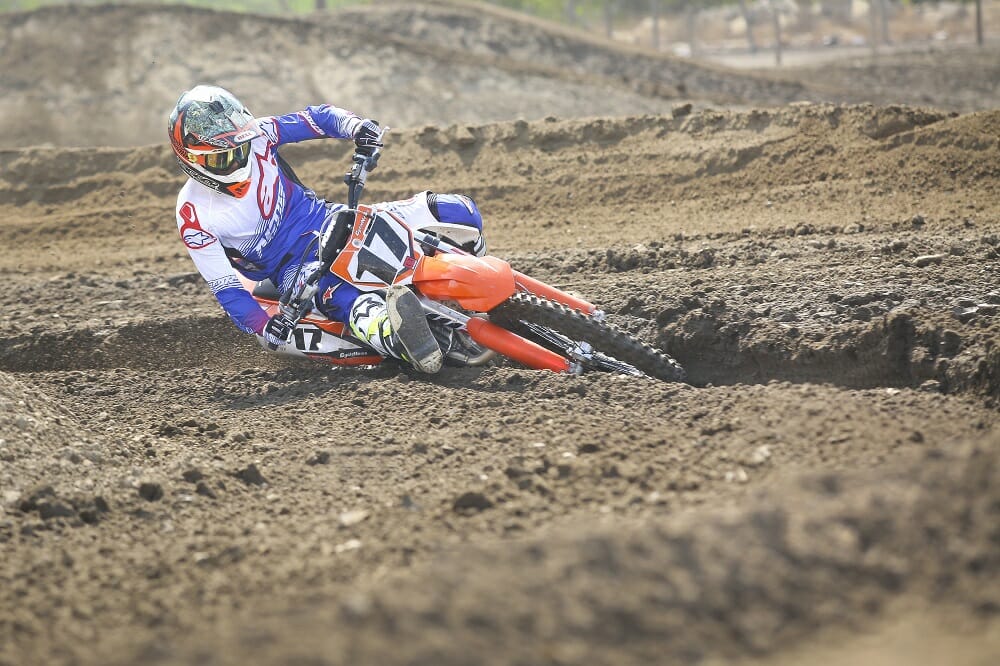 There is nothing that the KTM doesn’t do well, like railing rutted turns.
There is nothing that the KTM doesn’t do well, like railing rutted turns.
In last year’s 2016 Cycle News shootout the KTM 450 SX-F came very close to winning against the YZ450F. With the new WP AER48 air fork and other revisions the 2017 KTM has clawed its way to the top to win the 2017 Cycle News 450 Motocross Shootout. It is the lightest bike in the class, yet features electric starting, a hydraulic clutch and high-quality components. And the bike just plain performs.
The KTM’s engine provides a wide range of power characteristic thanks to a choice of maps and traction control. Choose the stock map (number “1”) with traction control and it rolls on smoothly without any scary moments in the rpm range. Turn traction control off and switch to aggressive map “2”, and you have a 450 engine that still rolls on smoothly off idle, then pulls into a very strong midrange. That midrange power doesn’t sign off and the KTM revs farther and stronger than any other 450.
Riders who are used to highly responsive 450s that jerk forward as soon as there is tension on the throttle cable might think the KTM 450 SX-F isn’t very fast. Well that is just the opposite; its ultra friendly bottom-end, drives the bike and rider forward and into the strong midrange with predictability. Many might consider that lack of excitement but we call it making traction and reducing fatigue. It should also be noted that the isn’t nearly as loud as the Yamaha, Honda and Kawasaki, while still pumping out the most horsepower in the shootout. (The Husky is the quietest bike to our ears.)
KTM made a great choice when replacing the WP4CS fork with the AER48 air fork, it is the best performing production air fork and weighs 3.5 pounds less than the old spring fork. The AER48 doesn’t feel like the typical air fork we are used to, it feels like a good performing spring fork. It only has one valve to adjust, making it very easy for the average consumer who doesn’t want complexity.
The KTM 450 SX-F feels light when lifting it off the stand and even lighter on the track. Throwing around the 450 SX-F feels like riding the world’s fastest 250F. Because it is light, initiating direction change is easy and the smooth, but strong power delivery provides awesome traction in any condition. The updated chassis in 2016 provided more stability, and, now with the addition of the AER 48 fork the 2017 KTM 450 SX-F is even more stable, an impressive feat, especially for a bike that is wicked good in the corners.
Suzuki has typically held the cornering title but the KTM gives it a serious run for that honor. The advantage the KTM has is its ability to stay calm and predictable entering corners while the suspension on the RM-Z450 can make it a guessing game as to where the bike will end up once you finally make it to the corner entry. There are so many ways to describe the 2017 KTM 450 SX-F, but the easiest to simply call it awesome.
Every component of the 2017 KTM450 SX-F ties together to create an excellent 450 motocross bike. The engine character, mated with a predictable chassis and great suspension makes it a fun and competitive race bike. It is the lightest production 450 motocross machine out there, even with electric start. The KTM just has too many things going for it, including most importantly, all-around great performance, that we couldn’t not declare the KTM as our 2017 Cycle News 450 MX Shootout winner.
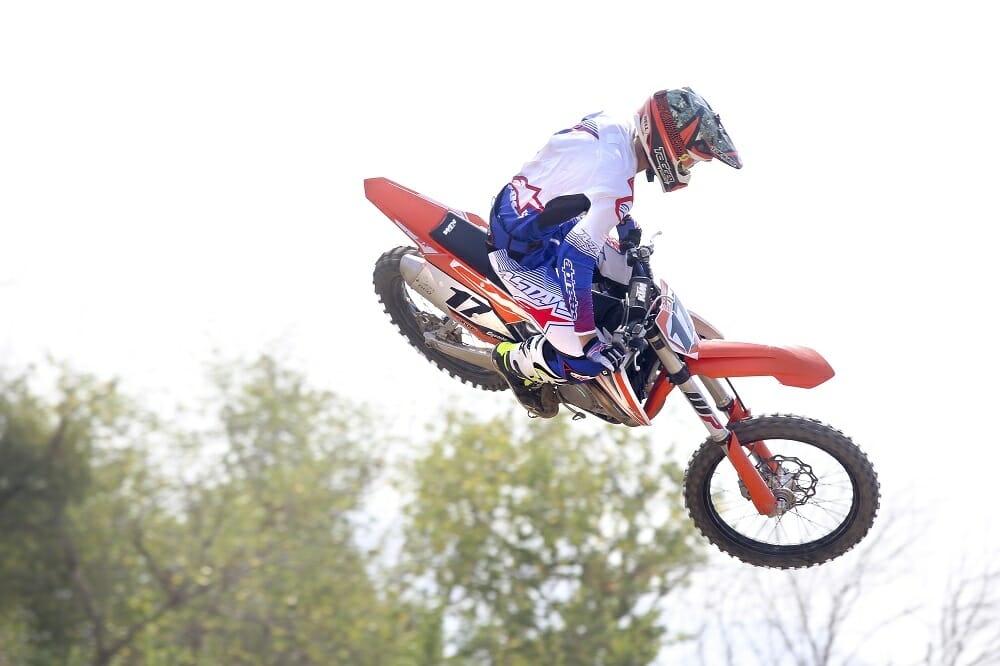 The KTM has a lot to offer: electric starting, light weight, traction control (that actually works), launch control, engine modes, etc. Put it all together and you have a shootout winner.
The KTM has a lot to offer: electric starting, light weight, traction control (that actually works), launch control, engine modes, etc. Put it all together and you have a shootout winner.
|
PROS
|
CONS
|
IMPORTANT NUMBERS
|
|
Lightest production 450
|
Pricey
|
Weight (full fuel): 233 lbs.
|
|
Electric (super-easy) starting
|
Weird launch control design
|
(w/o fuel): 221.0 lbs.
|
|
Hydraulic clutch
|
|
MSRP: $9399
|
|
MX32 tires
|
|
|
|
Traction Control
|
|
|